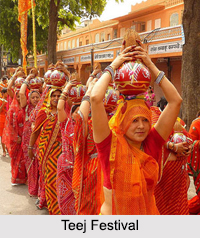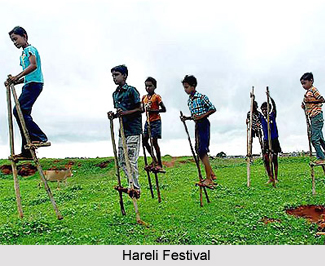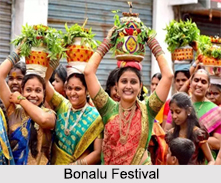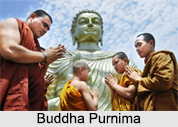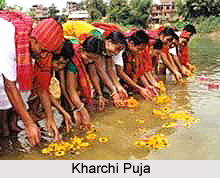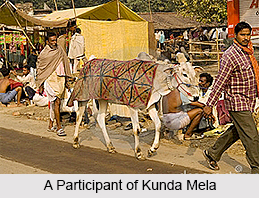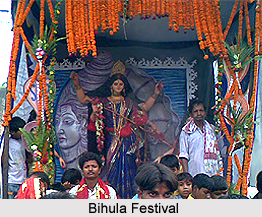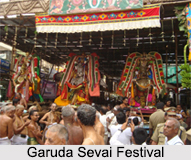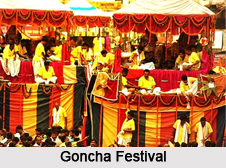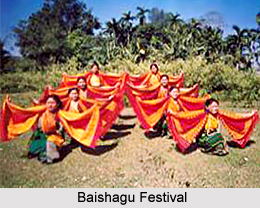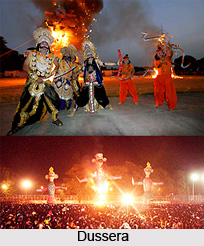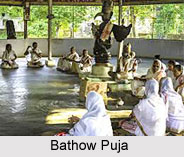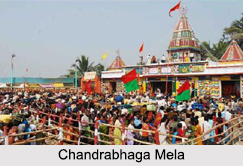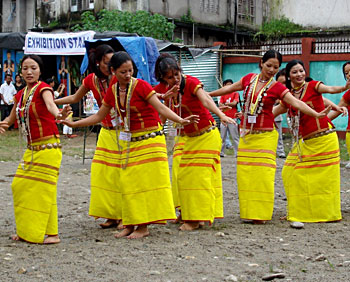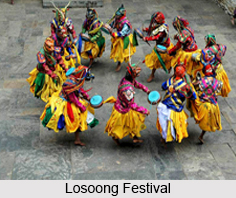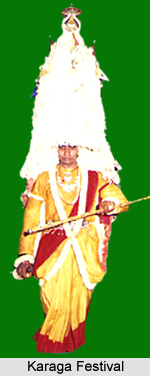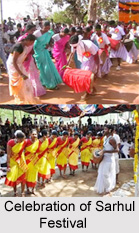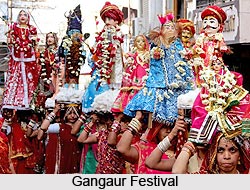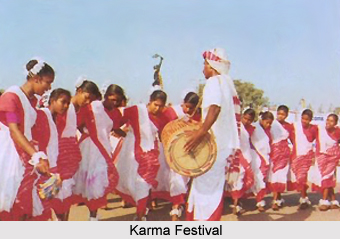The confinement and post birth rites are being performed to ward off the evil from the child and the mother. To prevent mischief to the mother or the child, a number of precautions are taken during the confinement. Firstly the confinement room should be a private place so that the pain of labor should not make any noise. Publicity increases their severity. A cat should not be entering the room at any cost nor should the mother hear the cat`s call. Secondly, the widespread custom in rural areas is to cause the delivery on the ground, where fire is kept and a lamp must be kept burning all night. If the lamp blows out, it is believed to be an ill luck for the child. Thirdly, grains, as an emblem of good luck and water, as a purifier, are kept near the bed always. Fourthly, a weapon symbolizes a protector, is thus used against evil during the hour of labor, and should be kept close by the mother. Fifthly, the house should not be swept with the broom or else the luck may be swept away. No drain should be kept open or else ill luck enters by an opening, which must be dirty.
The umbilical cord that connects the baby and the mother is cut with a sharp knife. This rite is performed by a sweeper in villages and by a midwife in the cities. The secundines are later buried in a corner of the house. If a mother dies within thirteen days of her delivery, it is believed that she will return in the guise of a wicked spirit to torture her husband and family. To prevent this, Shattti Yagnye is performed at her funeral. Immediately after her death, 4 nails are forced into the ground all round the corpse, and when it is taken from the house door to the cremation ground, rape seeds are scattered all the way behind it.
Sutak or Chhut is the period of impurity that varies from 10-30 days. Ten days among Brahmins and twelve days among Kshatriyas. However, in case of Vaishyas, its 15 days and thirty among Sudras, thus the purity of the caste is the main factor that decides the number of days. But in practice the period of impurity is at the maximum of thirteen days. Neither mother nor the children are allowed to come out of the confinement room for thirteen consecutive days.
On the thirteenth day, the mother gives away her old clothes to the midwife sweepers; sometimes the barber`s wife shares these clothes. The barber`s wife or nairi brings cow`s urine and sprinkles it with grass around the mother. Then she burns incense sticks and pares her nails for the first time ever since she entered the confinement. Then the mother puts on her slippers and walks out of the room with the child in closely held in her arms. A menial with a pot of water and some green grass receives her outside the room. In the outer room, an idol made of cow dung is made, covered with a red cloth and the mother worships it as a Goddess. Only women are only supposed to attend the occasion and no man or Brahmins are allowed. The girls are fed and there is too much of drum beating.
There are a number of rites performed on other days as the post birth rites.
Third day: On this very day, the mother comes out of her confinement room at a favorable hour that is decided by a Brahmin after much calculation. The women offer grain, which is touched by the mother of the child. Songs are sung in the room. Jaggery is distributed among all women. The people, who owe this family, get their dues. The barber places the blades of dubh grass or cynadon dactylon inside the turban of the child`s forbears, indicating that they may multiply like grass. The mother takes bathe on the third, fifth or the seventh day. And Churi is made using the baked flour, sugar and ghee. This is then distributed among the females of the brotherhood.
Fourth day: The mother takes bath on the fourth, seventh, thirteenth, twenty-first, thirtieth and forty-eighth day, in some regions.
Fifth day: Without the bathing, the ceremony cannot be started on this day. After bathing the foster brother bring a blend of cow dung and grain, sweets and bread is well placed beneath it. The mixture is covered with a red cloth and then given to the midwife. The mother then takes a bath with milk and cow`s urine. The barber`s wife ties and plaits her hair. The yard is then mopped with cow dung thoroughly. The mother then comes and rests in the room that has been cleaned and plastered with cow dung. The rice, loaves and sweets are then distributed among the brotherhood. The women who come to visit the mother usually bring grain and money. These grains and money are then distributed between the midwife and the barber`s wife.
Sixth day: The ceremony called the Chhati is held on the 6th day. On this day, the mother and her family worships Shashti Devi. The role, significance and worship have been mentioned in details in Brahmvayvartey PurHna. Lord Visnu once said that the sixth section of nature was established as Shashti. She was the patron of children and was the strange illusion of Lord Visnu that imparted the benefits to the children. This Goddess imparts long lifecycle. Also this Goddess looks after protection and safety of the children. By asset of her mythological yogic powers, she is always close to the infants. On the sixth day, the mother bathes and purifies herself and thus observes a fast all across the day. At sunset, she is also given some rice and all her loved eatables to eat. Some family members keep a close eye on the mother throughout the night to attend immediately in case of any problem. A paper and writing material are always kept ready. It is believed that the Goddess will come sometime in the night and write the fortune of the infant.
Seventh and tenth days: In some areas, these days are celebrated when the mother takes a bath, worships a lamp placed before the idol placed on a pile of grain. She is clad in new clothes on this occasion. Each woman of the neighbourhood gives her a coconut and five dates on the tenth day. Lastly the idol is taken away and placed under a palm tree. The kinsmen are feasted.
Thirteenth day: This day is very important, as already described. The mother is bathed. All earthen vessels in the house are broken into pieces or replaced by new ones. Clothes are washed, the house is plastered, and Brahmins are fed. Occasionally the child is named mis day.
A month after: A month or so after the birth of the child, a rite called Well worship or Daghar Puja is observed. If the mother is becomes weak and is unable to walk the distance to the well, other women of the house place a jar beside her and they carry it to the nearest well, singing songs as they go. The well is also worshipped, rice and dubh grass are offered. On their return, the attendees get rewards.
Suckling: Immediately after birth, the midwife who is present during the delivery washes the child in a vessel, on which her prize is placed. The midwife then gives the baby to the mother. The child is however not allowed to suckle for one and a half days. Right after the birth, a little honey is poured in the mouth of the child. Suckling the child for the first time is also known to be a ceremony. At sunset, the midwife washes the mother`s breasts with water, using some grass leaves like the brush. Some jaggery is placed on the lips of the child and suckling is then allowed. Some other females also wash the breasts and all of receive money as reward. Fosterage is usually not done.
Clothing the child or Chola: The time of putting on clothes on the child varies from the first day to the thirtieth day. No special ceremony is usually held on this occasion, but the midwife and the barber`s wife are rewarded. On this day, in some regions the family goes to the God`s temple or some Muslim shrine.
Chhuchhak: On the birth of the child, the parents of the mother send sweets, clothes, and ornaments to the mother, her husband and the child.
Hijra (Eunuch): Although there is no religious observance in this case. But this ritual is still advent in the outskirts of the city. This aspect of the visiting the Hip-as on the birth of a child is of widespread application, in all sectors of India. How they come to know about the birth of a child and what the system they adopt for the purpose is still a mystery. When a child is born in any family, a group of Hijras, clad in gorgeous saris, visits the house where the child has been born. They sing, dance and hold the child in their hands, bless the child and demand rewards, which greatly varies according to the status of the family and sex of the child. If a eunuch takes birth, Hijras take it away.
Festivals: Diwali in Oct-Nov and Lohri in January are celebrated with special pomp and show after the birth of a child. Greater lighting than usual is done on such first occasion of the child. The next sacrament name giving or Nam Karan is regarded as a serious religious ceremony of importance.
